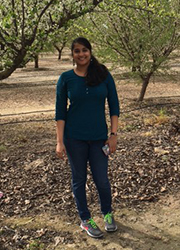Global Food Initiative
Kripa Akila Jagannathan
GFI Fellow - Class of 2015
Graduate Student, Energy and Resources
Lawrence Berkeley National Laboratory/UC Berkeley
Project
Are Climate Model Outputs Aligned with Farmers' Information Needs?
Description
The aim of this project was to examine whether the outputs of climate models are aligned with California almond growers’ information needs. The project identified the climatic metrics that are relevant for the almond crop, and assessed whether these metrics can be computed from climate model outputs. The skill level of the Community Climate System Model (CCSM) in computing the identified metrics was also evaluated through a comparison of the model outputs with observed climate data.
Goals
The major goals of the project were to identify relevant climatic metrics for almond crops, assess if these could be computed by currently available climate models and examine the skill of the climate models in capturing the metrics of relevance. The key findings of the project were that chill hours in the winter months were the most important climatic metric for almond growth. The climatic observations in the last two decades have shown a decreasing trend in the number of chill hours. However, the Community Climate System Model’s projected data for the same period overestimated the number of chill hours and was unable to capture the decreasing trend in the chill hours. This cold bias could be corrected to some extent through a simple mean bias correction of the modeled data with respect to actual observed temperature data. However, the decreasing trend was still not evident in the corrected data. Further analysis of additional climate models, different bias correction methods, etc., are some of the next steps which would help identify the best climate models and assessment methods for projections of chill hours in California.
Future Plans
This project will serve as a first step for further work on the topic as part of my Ph.D. I am continuing work on the project this summer assessing more climate models and other bias correction methods. I also will work on identifying what kind of information is best predicted by the climate models. In the next academic year, I will be working with UC ANR's Cooperative Extension to conduct interviews with farmers to further understand the role of climate information in farmers' decision-making processes.
Mentor
Andrew Jones

